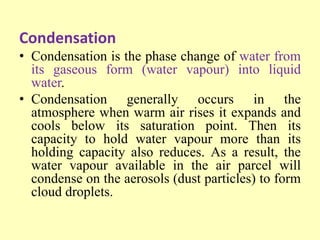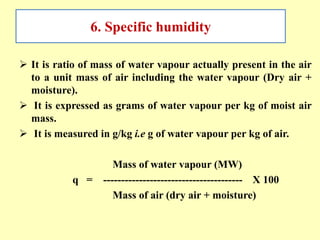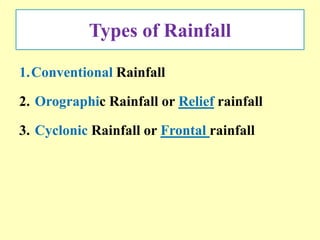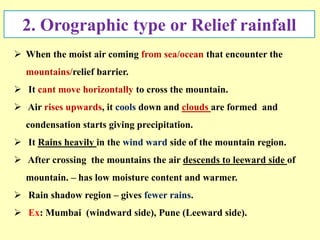humidity.pptx
- 1. Humidity is a measure of the quantity of water vapour in the air Humidity is nothing but water vapour present in the atmosphere It refers to the water in the gas form in the atmosphere • It is measured in either relative terms (relative humidity) or absolute terms (dew point temperature). Atmospheric Humidity
- 2. Condensation • Condensation is the phase change of water from its gaseous form (water vapour) into liquid water. • Condensation generally occurs in the atmosphere when warm air rises it expands and cools below its saturation point. Then its capacity to hold water vapour more than its holding capacity also reduces. As a result, the water vapour available in the air parcel will condense on the aerosols (dust particles) to form cloud droplets.
- 3. Source: 1. The water from different water bodies like ocean, sea, river, lake and soil moisture is gets evaporated. Also the water transpired and subsequently evaporated from the plants. 2. Solar energy brings about evaporation by supplying necessary energy. Besides the evaporation, convection, diffusion and wind also supply water vapour to the atmosphere. 3. The percentage of water vapour in the atmosphere is highly variable and changes according to season, land and sea presence . 4. Water vapour decreases with height & most of the atmosphere moisture content exist below 500 mb at 5574 meter heightt. Atmospheric Humidity
- 4. Humidity mainly depends on air temperature. The changes of moisture between the surface and the atmosphere determined the humidity. How the moisture move to atmosphere: The flux of water vapour is upward. The evaporative loss is maximum/strongest during the day and often continuous at a reduced rate throughout the night. Combination of high temperature and high RH adversely affect all life (human, animal and plant) as the humidity declines, the vapour pressure gradient between leaf surface and surrounding air increases and consequently rate of evaporative cooling rises through higher heat loss.
- 5. Different terms of Humidity: The temperature of the environment is closely associated with the amount of water vapour present. Water vapour in the air condenses & takes different forms like rain, snow, hail, sleet etc. Therefore humidity is an imp weather element and it is expressed in different terms. 1. Partial vapour pressure: • When water vapour make mixes with other gases of atmosphere, it exerts pressure in all the directions as that of other gases. • It is the part of atmosphere pressure due to water vapour is known as partial vapour pressure. So it is the combination of water vapour and gases that the total atmosphere pressure.
- 6. • Total pressure Pw = PO2 + PCO2 +PN2 +PH2O • The pressure exerted by actual air (dry air) is known as actual vapour pressure.
- 7. 2. Dew point temperature • It is defined as the temperature at which the actual mass of water vapour present in certain volume of air is just able to saturate it and the invisible water vapour begins to condense into the visible form like small water droplets. • This is the temperature at which dew appears. • Usually 50C is considered as dew point temperature.
- 8. 3. Saturated water vapour At a given temperature, air holds certain amount of vapour which is given by the vapour pressure at that temperature. When air contains all the moisture that it can hold to maximum limit is called saturated air otherwise it is unsaturated.
- 9. 4. Relative humidity (RH) Actual qty of water vapour/given vol. of air RH = ----------------------------------------------------------------------- X 100 Max qty of water vap that air can hold by the same vol of air SVP at dew point = ---------------------------------- X 100 SVP= sat. vap pressure SVP at air (room) temp. • Relative humidity is given always per cent. The RH represents the amount of water vapour actually present in the air, compare with the maximum amount the air can hold at a given temperature. • It tells simply the relative content and indicates the degree of saturation of air at a given temperature with water vapour. • The RH of saturated air is 100%. Ex: RH is 80% means 20% moisture is required to saturate the atmosphere.
- 10. 5. Absolute humidity (AH): (Actual Humidity) It is defined as actual quantity by water vapour present in the given volume of air. It is measured in g/m3 or lbs/ft3 or in terms of partial pressure of water vapour in air in mb or mm. Wt. of water vapour AH = ----------------------------------- X 100 Vol. of air
- 11. 6. Specific humidity It is ratio of mass of water vapour actually present in the air to a unit mass of air including the water vapour (Dry air + moisture). It is expressed as grams of water vapour per kg of moist air mass. It is measured in g/kg i.e g of water vapour per kg of air. Mass of water vapour (MW) q = --------------------------------------- X 100 Mass of air (dry air + moisture)
- 12. 7. Mixing ratio It is the mass of water vapour measured in grams of mixing which 1 g. of dry air. Mass of water (MW) MR = -------------------------------- Mass of 1 g. of air It is differs from specific humidity, it is related to only air instead of to the total dry air + vapour in case of specific humidity. Instruments used to measure humidity are called Hygrometer.
- 13. Precipitation
- 14. Precipitation • Precipitation refers to the transfer of water from the atmosphere to the surface of the Earth, in the form of rains, ice crystals, snows and hails.
- 15. Types of Rainfall 1.Conventional Rainfall 2. Orographic Rainfall or Relief rainfall 3. Cyclonic Rainfall or Frontal rainfall
- 16. 1. Conventional Rainfall Common in tropical countries or high temperature areas. Due to heating, the air near the ground – hot and starts upward movement (Convection). Lapse rate : DALR Dry Adiabatic Lapse Rate 9.8 0C/km Air becomes saturated and attain humidity 100% at which dew point is reached where condensation starts. This height is called at SALR – Saturated Adiabatic Lapse Rate 4 0C/km Here first cloud is formed – “Conventional rain “
- 19. 2. Orographic type or Relief rainfall When the moist air coming from sea/ocean that encounter the mountains/relief barrier. It cant move horizontally to cross the mountain. Air rises upwards, it cools down and clouds are formed and condensation starts giving precipitation. It Rains heavily in the wind ward side of the mountain region. After crossing the mountains the air descends to leeward side of mountain. – has low moisture content and warmer. Rain shadow region – gives fewer rains. Ex: Mumbai (windward side), Pune (Leeward side).
- 20. Orographic or relief rains
- 22. 3.Cyclonic Rainfall or Frontal rainfall It is produced when opposite air currents (warm and cold) meets Vertical lifting of air mass takes place. – Condensation, precipitatiom. When warm air mass meets cold air mass, the colder air being denser tends to push below the warm and light air & replace it. The boundary zone along which air masses meet – Fronts The settled cold air pushes warm air vertically & results convection When warm air mixes with cold air mass, the temp. of warm air falls down, saturation takes place and precipitation. Such mechanisms are responsible for cyclone formation Rains received from cyclone are called “Cyclonic rains”.
- 23. Cyclonic or frontal rains……
- 24. Process of THUNDER STORMS
- 25. Process Thunder storms In the formation of thunder storms the cumulonimbus clouds are produced by the upward motion of the humid air. Condensation of water vapour and formation of many rain drops. In the strong upward motion of the air, these water drops are broken up and electrified positively. The air with its –Ve charge. Large quantity of +Ve and –Ve charges accumulates in different regions and the electric force are increases until lighting flash .. The process repeated and temp. created enormous about 50,000 0F (27,7600C). Air gets suddenly expanded and molecule atoms dissociated with a large noise which is known as thunder.
- 26. Forms of Precipitation • The usual forms of precipitation are 1. rain 2. drizzle 3. snow 4. sleet 5. hail
- 27. Rain, drizzle - Occurring during the monsoon & summer seasons Snow, sleet - Occurring during the winter season. Hail, shower - Occurring during the summer season due to high intensity of rainfall
- 29. 1. Rain Rain is the precipitation of liquid water particles in the form of drops 0.5mm diameter or smaller to widely scattered drops. When the precipitation process is very active, the lower air is moist and clouds are very deep, then the rainfall will be in the form of heavy down pour.
- 30. 2. Drizzle Fairly form of precipitation having fine or very small droplets (<0.5 mm diameter) which are carried away by the light winds. The drizzle falls from low laying nimbo- stratus clouds, if the drop of drizzle completely evaporates before it reaching the ground is called mist.
- 31. 3. Snow It is the precipitation of solid water in the form of white and opaque grains of ice. In water when the temp is below the freezing point in the whole atmosphere, ice crystals falls from the alto- stratus clouds.
- 32. 4. Sleet It is the precipitation in the form of mixture of rain + snow (both form of liquid + solid). It consists of small pallets of transparent ice of 5 or <5 mm diameter. It is referred to as frozen rain, when air falling to the earth passing through a layer of cold air & freezes in very low temperature. It is not commonly seen in India except the ranges of north & north-east during winter season.
- 33. 5. Hail It is a precipitation of small pieces of ice which a diameter up to 50 mm or more. The rainfall associated with the hail stones are called as Hail storms. The highest hail recorded was 152 mm weighing 766g at Canoas, USA on 3rd Sept. 1970. In India during the month of March, April & May receiving this type of hail storms. The thunderstorms of cumulo-nimbus clouds are most dreaded and destructive from of precipitation.
- 34. 6. Shower It is the precipitation lasting for short time with relatively clear intervals. Usually it occurs from the passing / moving clouds.

































